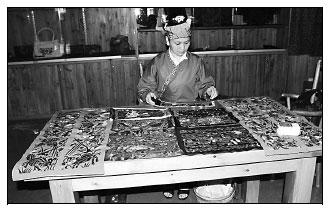Local intangible cultural heritage will be a highlight of the Colorful Guizhou 2015 Cultural and Creative Industries Fair, said organizers of the event.
The three-day fair will begin on Friday in Guiyang, capital of Southwest China's Guizhou province and will attract more than 130 exhibitors, as well as an expected 300 professional visitors from across the country.
"Further development of the cultural and creative industries in Guizhou must depend on intangible cultural heritage," said Chen Longjie, curator of the fair. "The province is rich in such resources."
He said intangible heritage is the most important feature and advantage of the province's cultural and creative industries.
Guizhou has 85 national-level intangible cultural heritage items and 561 provincial-level items, according to organizers of the fair.
The event has a 2,400-square-meter exhibition hall that will display all 10 types of China's intangible cultural heritage and so become the country's first provincial-level comprehensive intangible cultural heritage exhibition hall.
Some of the 10 types are folk literature, traditional music, traditional dance, traditional crafts and folk customs.
Organizers of the fair said they will exhibit objects, models and videos of the majority of Guizhou's intangible cultural heritage items including costumes of the Miao ethnic group and an epic about King Yalu - a hero of the Miao people.
They will also invite 20 national-level and provincial-level inheritors to demonstrate intangible cultural heritage skills at the fair and teach visitors crafts and skills, such as how to make Yuping bamboo flutes and sing the "grand song of the Dong ethnic group".
The fair will combine local intangible cultural heritage items and cultural creative products, Chen said.
Ancient papermaking techniques from Shiqiao village in Danzhai county will be displayed in the intangible cultural heritage hall while lamps and furniture made of the paper will be seen in the cultural creation experience hall.
Chen said that creativity promotes innovative development of heritage items and helps better protect them.
The fair also comprises a 7,000-sq-m intangible cultural heritage dining hall that will offer food from 48 counties in Guizhou. The gate of the dining hall is in the style of a Miao costume.
To help visitors better experience local intangible culture, the organizing committee has set up a theater where spectators can watch performances related to intangible cultural heritage.
Cultural creative exhibits at the fair are mainly silver ornaments, embroidery products, bamboo flutes, packaging, tourism souvenirs and glass artworks.
The Guizhou government has long focused on the protection of its intangible cultural heritage, according to the organizers.
It has had a regulation for such protection since 2012 and annually earmarked some 30 million yuan ($4.8 million) in recent years to help protect and teach local intangible cultural heritage.
Zeng Jun contributed to the story.
yangjun@chinadaily.com.cn

|

An artist of the Miao ethnic group demonstrates the Miao embroidery technique, a national intangible cultural heritage item, at the venue ahead of the official opening of the fair.Provided To China Daily
|
(China Daily 07/22/2015 page17)


